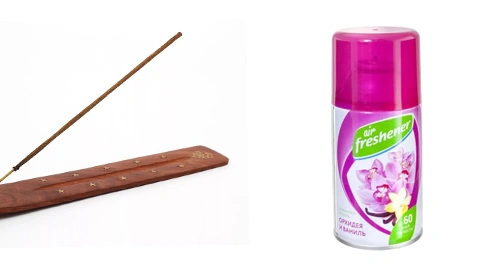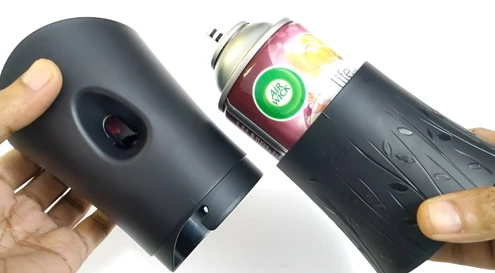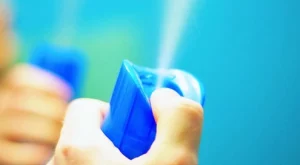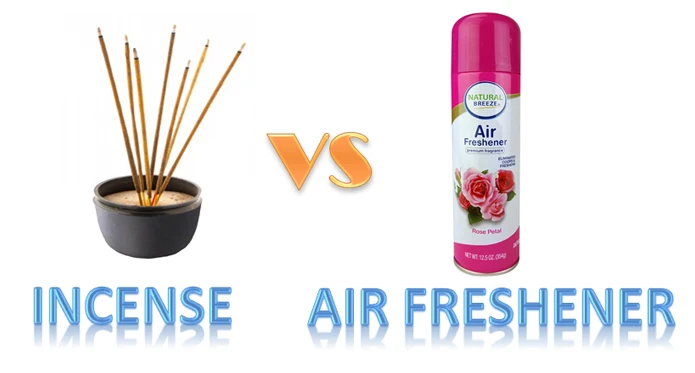Last Updated on January 16, 2023
Incense and air fresheners are practical ways of sprucing up your home and creating a pleasant, welcoming atmosphere. Incense and air fresheners can mask unpleasant smells and make your home smell nice. But, they work in different ways and have different benefits.
Air fresheners work by releasing a fine mist of fragrance into the air quickly, which only covers up smells rather than eliminates them. Incense works by slowly releasing fragrance into the air, which may take longer to notice than an air freshener. The scent of the incense will linger for some time after it has been extinguished.
While incense has been used for centuries for religious and ceremonial purposes, air fresheners only became widely available in the mid-20th century. Read on for more information about the differences between incense and air fresheners.
What’s the Difference Between Incense vs Air Freshener?

When it comes to making your home smell pleasant, you have a few different options. Two of the most popular choices are incense and air fresheners. But what are the differences between these two products? Here are some key points to keep in mind:
01. Ingredients
Incense is made from various natural materials, including wood, bark, leaves, and resins. These materials are then coated with essential oils or other home fragrance compounds. When incense is burned, the heat causes the essential oils to vaporize, releasing their scent into the air.
On the other hand, air fresheners typically contain synthetic fragrances that are released into the air using aerosol propellants. Some air fresheners also contain chemicals that mask unpleasant odors rather than neutralize them.
02. Fragrances
The main difference between incense and air freshener is that incense is made of aromatic compounds while air fresheners are not. Incense is made of burned aromatic compounds, releasing volatile organic chemicals (VOCs) into the air. VOCs are gas molecules that quickly evaporate at room temperature.
Air fresheners rely on mechanical processes to disperse fragrance into the air. For example, aerosol air fresheners use compressed gasses to propel fragrance oils out of the can. Gel air fresheners release fragrance as they slowly evaporate.
03. Effectiveness
While both options can mask unpleasant odors, incense is more likely to purify the air and help improve your overall sense of wellbeing. Air fresheners simply cover up odors without enhancing the air quality.
Also, incense provides a stronger and more long-lasting fragrance than air fresheners. Yet, this also means incense can be more overpowering than air fresheners.
04. Safety
When it comes to safety, incense is generally considered to be the more risky option. This is because incense burning can contain harmful particulates that can be inhaled. Also, it’s crucial to use incense responsibly by burning it in a well-ventilated area and keeping an eye on any open flames.
05. Their Use
Incense is made from natural materials such as herbs, spices, and wood. Incense is often used for its therapeutic properties, such as relaxation and stress relief. But, it can be challenging to control the amount of smoke produced, and it may not be suitable for people with respiratory problems.
Air fresheners are easy to use and provide a long-lasting scent. They are also available in various scents, from floral to citrusy. But, some air fresheners contain harmful chemicals, so it’s essential to read the label carefully before purchasing.
Today, incense and air fresheners perk up various indoor spaces, from homes and offices to cars and public restrooms. They are often used in combination to provide a pleasing scent and mask unpleasant smells.
Should You Decide Whether to Use Incense or Not?

Incense has been around for centuries, used in religious and spiritual ceremonies. But what are the best uses of incense, and what are their downsides?
Best Uses of Incense Sticks
Well suited for indoors: Incense sticks are one of the most popular ways for use in bathrooms, where they can help to reduce odors and create a relaxing atmosphere. These sticks can also be used in bedrooms, living rooms, and any other space where there is a need for a touch of fragrance.
Whole room aroma control: Incense sticks help control the aroma of an entire room. By lighting an incense stick and placing it in a central location, the fragrance will evenly disperse throughout the room, providing a refreshing and relaxing atmosphere.
Whether it’s cooking smells, pet odors, or just musty air, a few wafts of incense can help to make any space more pleasant.
Setting the mood: Incense sticks are often used to set the mood and create an ambiance of relaxation. The fragrant smoke from these sticks can help to mask other smells and can also help to reduce stress levels, making them ideal for use in any environment where you want to create a calm atmosphere.
Insect repellents: Aside from their use as aromatherapy, incense sticks can also act as insect repellents. The strong scent of sticks like these can keep bugs away, which makes them ideal for areas where insects are a problem.
Downsides of Incense Sticks
Burning ember caution: One of the main dangers is that they can be a fire hazard. The burning ember at the end of the stick can easily fall onto carpets or other flammable materials, causing a fire.
Ash control: As the sticks burn, they produce a small amount of ash that can quickly accumulate on surfaces. These ashes can be challenging to clean up, and if they aren’t disposed of, they can be a fire hazard.
How do Air Fresheners and Incense Sticks Eliminate Odors?
In most cases, synthetic fragrances are contained in air fresheners, which are dispersed through an aerosol can or electrically-powered Diffuser. Their fragrance can be released in the form of a fine mist.
This can be helpful in quickly masking bad smells, such as cooking odors or pet smells. Regardless, air fresheners only cover up smells rather than eliminate them.
The ingredients used to make incense are plants that have been processed into a powder or paste, then rolled into sticks or cones. When the incense burns, the heat causes scent molecules to be released into the air. It produces fragrance by slowly dispersing it into the air.
This can take more time to notice than air fresheners, but the scent lasts long after the incense is finished burning. Some people find the process of burning incense to be relaxing.
Relevant: Why Is My Air Freshener Not Working?
Should You Decide Whether to Use an Air Freshener or Not?

The use of air fresheners helps your home smell better. But before you reach for that can of air freshener, you should consider their uses and the potential risks:
Best Uses of Air Freshener
Instant aroma control: Air fresheners provide instant aroma control and can be used to mask a variety of unpleasant smells. They are not just for hiding bad odors; they also help create a pleasant atmosphere in any room.
For example, many people enjoy using air fresheners with soothing scents like lavender or chamomile in their bedrooms to help promote relaxation before bedtime.
Unique fragrance: Air fresheners come in a wide variety of scents and formulations, making them a versatile tool for creating a relaxing environment in any space. Also, air fresheners can improve the smell of smoking areas, pets areas, and other areas where persistent odors are a problem.
Clothing, textile, and hair: Air fresheners are often used to mask odors but can also be used to refresh clothing and textile. When sprayed on clothing, air fresheners can help to remove musty smells and leave a light, pleasant scent.
They can also be used to refresh hair between washes. Simply spray a small amount onto a brush and brush through the hair.
Downsides of Air Freshener
Contain volatile organic compounds: Air fresheners can contain volatile organic compounds (VOCs), which can harm human health. Studies have linked VOC exposure to various problems, including respiratory irritation, headaches, and dizziness.
Which is Better – Air Freshener or Incense?
Air fresheners are a popular way to make a space smell pleasant but can also be quite chemically. Incense might work for you if you’re looking for a more natural option. For centuries, incense has been used for its fragrance and ability to mask other kinds of odors. Incense is made from plant materials like resins and bark.
It’s important to choose high-quality incense to avoid inhaling chemicals, but incense can be a much safer alternative to air fresheners when burned correctly. Plus, it’s easy to find Incense in various delightful scents to enjoy your favorite fragrance without synthetic ingredients.
Ultimately, it comes down to your preference and what works better for you. An air freshener might be your best option if trying to cover up a strong odor. But incense may be the way to go if you want to add a lovely scent to your space.
Is Incense a Good Air Freshener?

Incense is often used as an air freshener, but there is some debate about whether or not it is effective. Some people find that the scent of incense helps to mask other odors in the room, while others find that it simply adds another layer of scent. There is also some concern about the health effects of burning incense.
Some studies have linked incense smoke to cancer, while others have found no clear link. Overall, it is difficult to say whether incense is a good air freshener. But, if you enjoy the scent and are not concerned about the potential health risks, it may be worth trying to freshen up your home.
Does Incense & Air Freshener Purify the Air?
Decorating your home with the pleasant smells of incense and air fresheners is common in many civilizations. But does this practice purify the air, as is often claimed? The answer, unfortunately, is no. While incense and air fresheners may mask unpleasant odors, they do not remove pollutants from the air.
Also, some air fresheners contain chemicals that can worsen indoor air quality. But some recent formulas are effective at trapping and removing certain airborne particles. So if you’re looking to purify your home’s air, it’s best to stick with natural ventilation and an air purifier.
Can I Use Incense & Air Freshener in the Bathroom?
Yes, you can use incense and air fresheners in the bathroom. But, there are a few things to remember to ensure your experience is enjoyable and safe:
To ensure proper ventilation, open a window or door. Incense and air fresheners can release harmful chemicals into the air, so it’s essential to allow them to disperse properly.
Be mindful of where you place the incense or air freshener. Avoid placing them near open flames, such as candles or the stove.
When leaving the room, ensure the incense or air freshener is extinguished.
These simple precautions will help you enjoy the benefits of using these products without risking yourself.
How Do You Get Rid of Bad Odors Naturally?
When it comes to getting rid of bad smells, many people reach for air fresheners or scented candles. While these products mask the smell, they often contain harmful chemicals.
If you’re looking for a more natural way to freshen up your home, try using incense. Incense is made from natural materials like wood, herbs, and resins, and when burned, it releases a pleasant smell into the air.
Incense can also help remove negative energy from the air and purify it. So if you’re looking for a natural way to get rid of bad odors, reach for some incense instead of an air freshener.
Relevant:
- Do Air Fresheners Make Allergies Severe?
- Where should I put the air freshener in the kitchen?
- How do you make your closet smell good?


